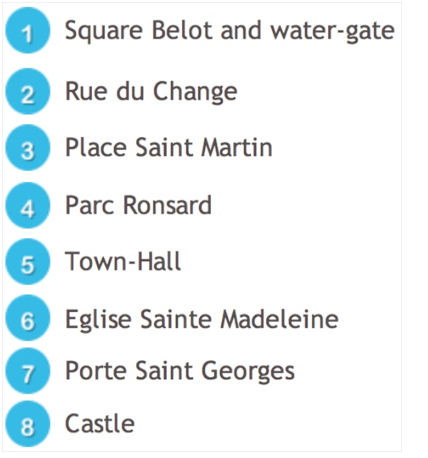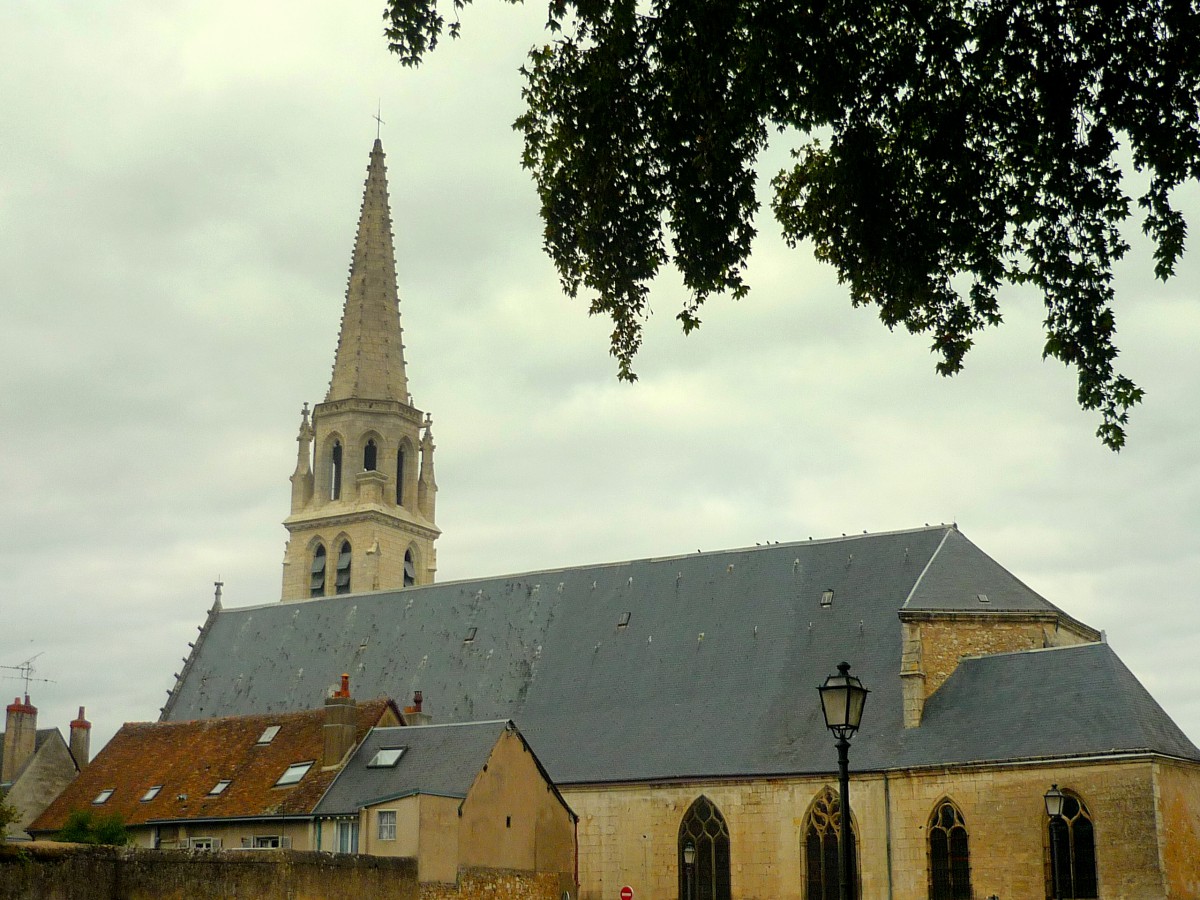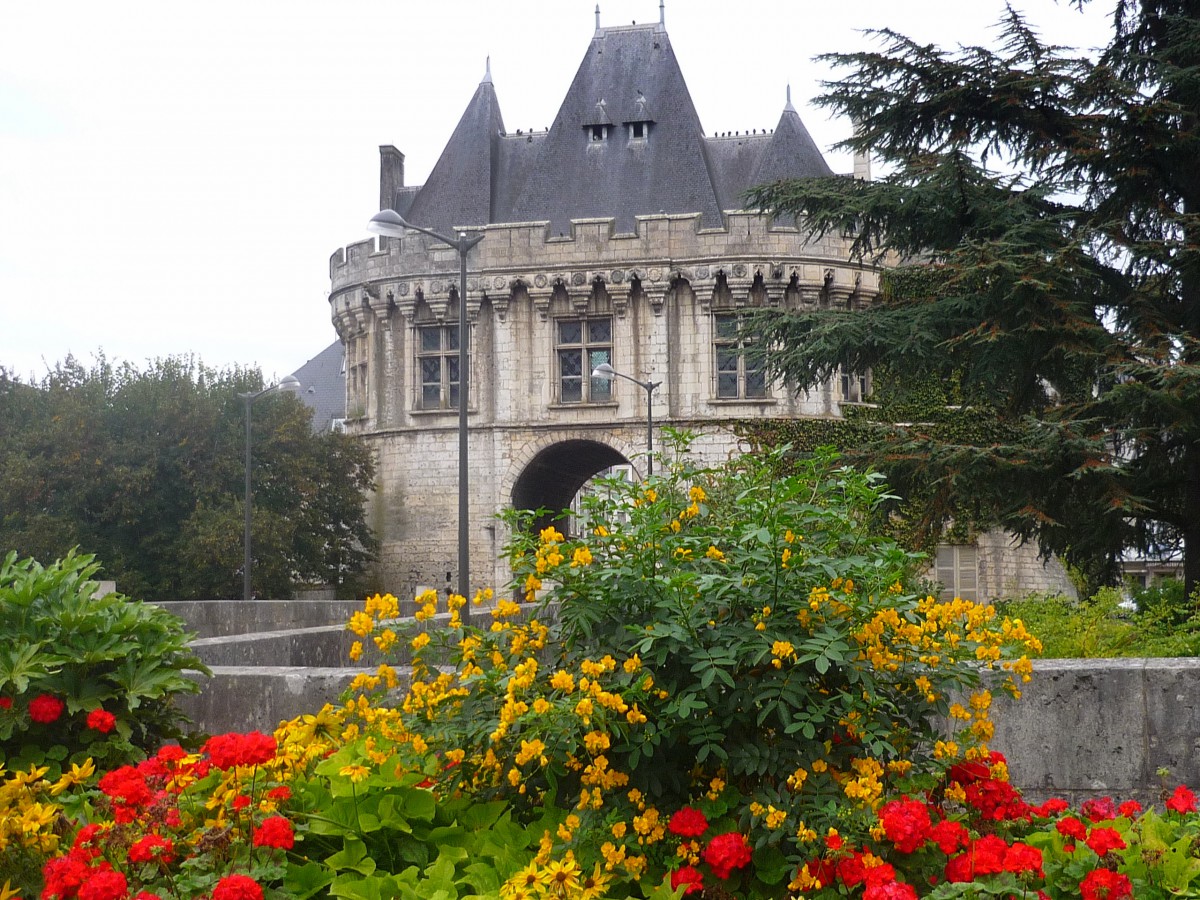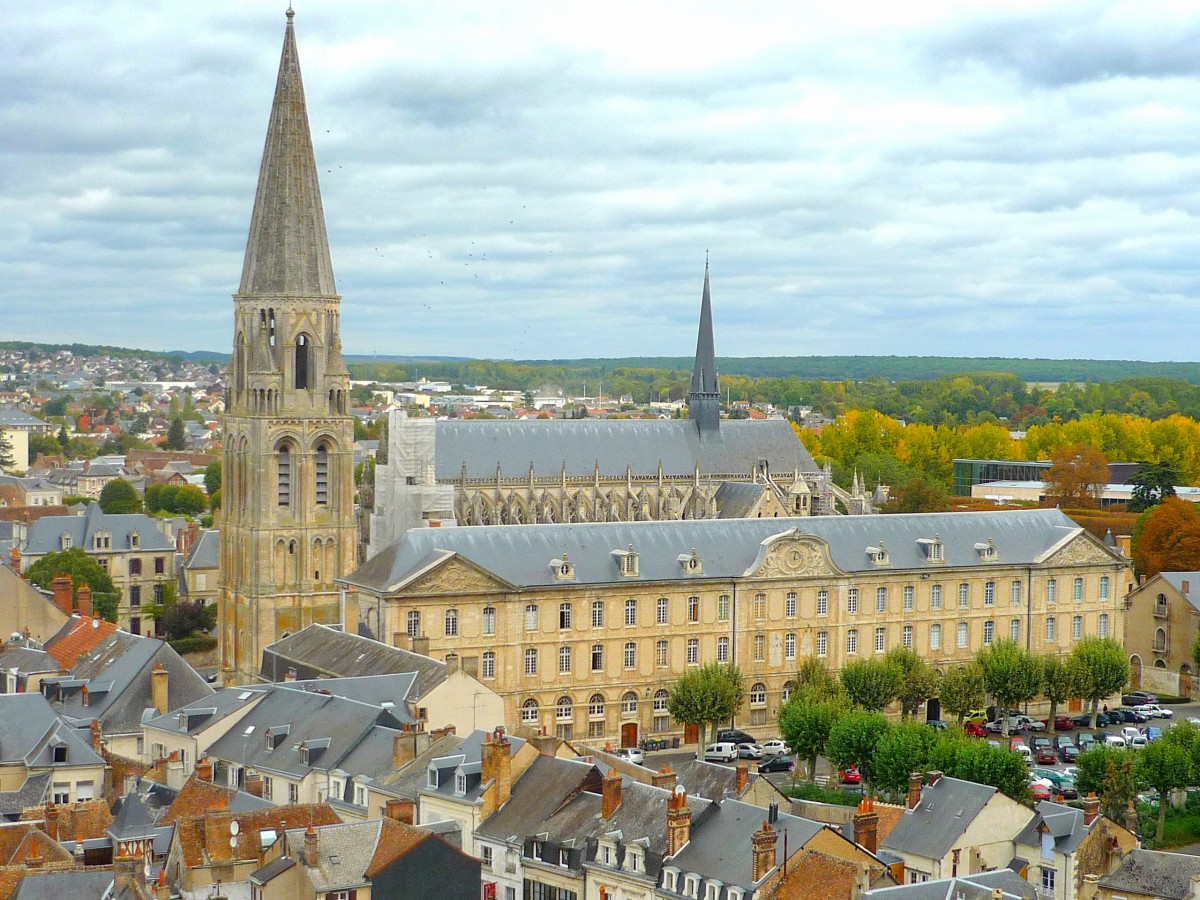Vendôme is the capital of the Vendômois, a rural region of green and hilly landscapes. The little town is steeped in art and history just 43 minutes from Paris by TGV. Criss-crossed by several offshoots of the River Loir and set into the hill surrounding the castle, the historic part of town boasts several interesting monuments, all a reminder of Vendôme’s rich past.
Since the 17th century, Vendôme has maintained a unique interest in the preservation of green space: plane trees, weeping willows, magnificent cedars, fantastic floral frescoes, all contribute to making the town a beautiful destination worth a one day visit. Let’s start the visit!
Let’s discover the town of Vendôme!


The banks of River Loir

The Loir is a tributary of the Sarthe River which it joins in Briollay, north of Angers. Not to be confused with the Loire River, running some 40 km south of Vendôme, the Loir is masculine in French (le Loir) whereas the Loire is feminine (la Loire). Both are pronounce the same in French [lwaʁ].
The historic part of Vendôme is bordered by two main offshoots of the Loir, hence the nickname “Little Venice”. Lined with plane trees, the banks of the Loir are perfect for a leisurely stroll.
The slope of the small gardens (“pente des petits jardins” in French) is the former name for Square Belot. On Square Belot, beautiful examples of floral frescos can be admired from the banks of the Loir River. The theme of these frescoes is changed every season. Because of the exceptional display of flowers throughout the historic part of town, Vendôme has been awarded the “four flowers” label in the national floral competition for ten consecutive years.

The Water Gate
The Water Gate (porte d’eau), dating back to the end of the 13th century, is a remarkable medieval structure spanning over a branch of the Loir River. Also named “Arche des Grands Prés” (arch of the great meadows), the Water Gate was part of a dam system designed to control the quantity of water needed to feed the watermills of the city.

The Islette Tower
The Islette Tower is located between Place de la Liberté and Carrefour des Rochambelles. The fortified tower was built in the 13th century as part of the medieval wall along the banks of the Loir River. Further on, the bridge crossing the river and leading to Rue du Change, known as “Pont Chartrain” was initially made of wood. Destroyed by a flood, it was rebuilt in stone in 1691.

The ramparts
The ramparts of Vendôme were abandoned in the 18th century following destruction during consecutive floods of the Loir River. They were not rebuilt because they had by that time lost their strategic advantage.

Rue du Change and St. Jacques Chapel
The Rue du Change is a pedestrian commercial street. It owes its name to the currency exchange which was established next to the bridge in 1354. The street was widened in the 19th century and, apart from the Saint Jacques Chapel, is lined with unremarkable buildings.

The Saint Jacques chapel is a fine example of Flamboyant Gothic style architecture of the 15th and 16th centuries.

From the 12th century, the chapel was known for welcoming pilgrims en route to Santiago de Compostela. The services of the Oratorians who were teaching in the nearby college were conducted in the chapel.
Disused during the French Revolution, the chapel became an armoury before being turned into an auditorium. Since 1982, it has been used to host exhibitions.
Place St. Martin

The square lies in the heart of the old part of Vendôme. It was previously occupied by the Saint Martin church the only remains of which is the majestic tower of Saint Martin.
The former Saint Martin church was dismantled after 1854 when the vault of the sanctuary collapsed. Today, the tower serves as the town’s belfry.
The “Carillon de Vendôme”
The “Carillon de Vendôme” is a French nursery rhyme from the 15th century. It takes its name from the chimes of Saint Martin tower which ring out their melody every hour. The old lament was composed in the Kingdom of France to describe the remaining possessions of Dauphin Charles VII following the events of the Hundred Years’ war. The Dauphin, disinherited by the Treaty of Troyes in 1420, kept only the cities of Orléans, Beaugency, Cléry, Bourges, and Vendôme.

Mes amis, que reste-t-il ? (to my friends, what is left?)
À ce Dauphin si gentil ? (to this Dauphin so gentle?)
Orléans, Beaugency,
Notre-Dame de Cléry,
Vendôme, Vendôme !
Les ennemis ont tout pris (the ennemies have taken everything)
Ne lui laissant par mépris (but only leaving him by disdain)
Qu’Orléans, Beaugency,
Notre-Dame de Cléry,
Vendôme, Vendôme !
Half-timbered houses
The square laid out around the belfry is bordered by a couple of interesting half-timbered houses from the 15th and 16th centuries.

One of them, the so-called “Grand Saint Martin” house with its horizontal beams, is adorned with escutcheons and statuettes. On the ground floor, the four sculptures depict from left to right Saint Martin, Saint James, Saint John the Baptist and Saint Louis.
Today, it is estimated that approximately 60 half-timbered houses survived destruction but their timber is mostly hidden behind plaster.
The Rochambeau statue
In front of one of them stands a statue of French nobleman and General Marshal Rochambeau. Born at Vendôme in 1725, Rochambeau was involved in the American Revolutionary War as the leader of the French Expeditionary Force who fought alongside the Americans.

Due to his help in securing American independence, the general is considered to be one of the Founding Fathers of the United States of America.
Parc Ronsard and the Town-Hall
The Parc Ronsard offers a shady green space to the locals.

The Hôtel du Saillant was formerly known as Hôtel du Bellay as it was built by the Du Bellay family. Today it hosts the Tourist Board of the Vendômois area.

On the other side of the park, the municipal library contains an exceptional collection of more than three hundred manuscripts.
Vendôme’s Town Hall
The Town Hall is located in a 1623 building. It was originally built by Duke César of Vendôme to house the college of the religious congregation of Oratorians. The edifice was then used a royal military school up to the end of the 18th century and then a high-school: the lycée Ronsard. When a new school was built in 1970 on another site, the municipal council moved into the building.

The architectural style of the building, made up of red brick and white stones, is reminiscent of many structures found in Paris, such as in Place des Vosges or Place Dauphine.
The Church of La Madeleine
The church of La Madeleine was completed in 1474 under the guidance of John VIII, Count of Vendôme. It owes its construction to the financial support of the locals, particularly the brotherhoods of winegrowers and gardeners who cultivated lands in the vicinity. It is topped by an elegant stone spire, echoing that of the abbey.

The interior was restored in the 19th century and features beautiful stained-glass windows from the Lobin de Tours workshop.
Porte St. Georges
The Porte Saint Georges is the only gate that remains standing today out of the four that used to enclose the city. On the river front, the gate features two large crenelated towers connected by a pavilion, as well as medallions from the 16th century.

In 1467, Count John VIII offered it in perpetuity to the city’s aldermen as a place to hold their meetings. Today, it is still used for council meetings as well as wedding receptions.
The abbey-church of the Holy Trinity

The beautiful abbey-church of the Holy Trinity is a marvellous example of Flamboyant Gothic architecture in France. The domain of the former abbey includes the church, the Romanesque bell tower, the cloister surrounded by buildings, the abbot’s lodgings and the granaries.
Read more about Vendôme Abbey.
The castle of Vendôme
To the south of the town, the ruins of the castle of the Counts of Vendôme overlook the old town on top of a hill. The castle estate covers approximately 1.5 hectares.
Visitors enter the castle grounds through the 17th century Beauce Gate which opens onto a beautiful and vast garden.
The former collegiate church
In the grounds stands the ruins of the former Saint Georges collegiate founded by Agnès of Burgundy.

Legend has it that in 1037, Agnès of Burgundy, Countess of Vendôme decided to establish a church because she was tired of going down the hill to attend the service at the Saint Martin church. She entrusted the church to canons, hence the name “collegiate church”.
From the 11th to the 17th centuries, many counts and dukes of Vendôme were buried in the collegiate, including Jeanne d’Albret and Antoine de Bourbon-Vendôme, parents of King Henri IV. This sanctuary of the Bourbon-Vendôme dynasty suffered devastation several times.

In 1562, the Huguenots, faithful to Jeanne d’Albret, pillaged the collegiate. Then, on the 28 May 1793, the tombs were desecrated by revolutionaries from Paris en route to Vendée. A few months later, the collegiate was entirely dismantled and its stones sold off.
The ruins of the collegiate were uncovered during the excavations of Abbot G. Plat in 1934 and 1935 and rows of yew trees were planted, following the floor plan.
The castle ruins
This historic monument is surrounded by ramparts of stone and soil punctuated by round crenelated towers from the 13th and 14th centuries.

The largest tower on the eastern side of the ruins is the Poitiers Tower which was rebuilt in the 15th century. It takes its name from William the Fat (Guillaume le Gros), Count of Poitiers who was imprisoned there in 1034 by Geoffroy Martel, then Count of Vendôme.
The castle was enlarged and enhanced during the Middle Ages, particularly during the Hundred Years’ War. In 1458, King Charles VII held a Chamber of Justice in the great hall of the castle to try the Duke of Alençon who was accused of treason.
Duke César of Vendôme transformed the castle into a residence in the 17th century but his successors neglected it. By 1791 the site was completely in ruins and was sold by auction to various landlords.
From the terraces, the site of the ruined castle commands a remarkable view of the whole city of Vendôme, the valley of the Loir and the neighbouring countryside.

Vendôme and Place Vendôme in Paris
Place Vendôme in Paris takes its name from César de Bourbon. Duke of Vendôme and the illegitimate son of King Henri IV and his mistress Gabrielle d’Estrées, he possessed a mansion formerly located on the site of the square.

Check out the website of the tourist board of Vendôme




